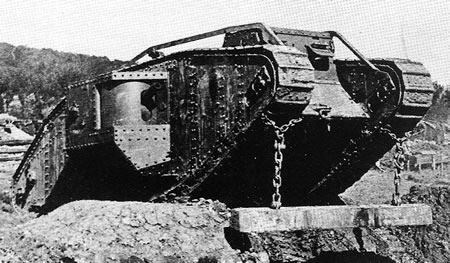There was an increased interest in these new war machines after their initial successes in the Somme in 1916 and more people came to sign up to drive them. The small tank companies became larger battalions, which all coincided with the government ordering 1000 tanks to be made ASAP. Two more tanks, the Mark II and Mark III, were soon produced. The Mark II’s were mostly used for tank training and had thinner armor, but some were used in battles at Arras in April 1917. However the tanks did not do well at Arras because of a three-week bombardment that tore the battleground to pieces and the fact that the Germans had plenty of time to prepare defenses. There were many disappointments with the Mark II and III’s, mainly, it is thought, due to the over-confidence of the British General Staff, who expected their new tank to overcome all obstacles and wreak havoc amongst the enemy.
The Mark IV’s were introduced under similar conditions at Messines in June 1917 but, though they had the same engine and gearbox setup, these tanks were made with slightly improved designs based on the actual battle experience of its predecessors. The new tanks had thicker armor, 12 millimeters (1/2 inch) thick, which was a lesson learned from the enemy armor-piercing bullets penetrating the hulls of earlier models. The chances of spontaneous flaming wrecks was reduced by putting the fuel tanks outside at the back and plating them with heavy armor, which was made possible by a new ‘Autovac’ system that didn’t rely on gravity to get the fuel to the engine. Breathing inside the Mark IV tank was made easier with the use of better ventilation and a proper exhaust for the engine.
The ‘male’ tanks had their six-pounder guns changed to shorter 23 caliber guns as the original ones were taken directly from ships, which were too long for effective use in the trenches. The ‘female’ tanks briefly had their Vickers guns changes for Lewis guns, which were very reliable in other circumstances but proved a bad fit for tanks as they sucked dust and smoke into the cabin with their air-cooled mechanism. Therefore, the female tanks were fitted with Hotchkiss guns instead, which ended up being fortuitous as they were lighter and afforded more room with the smaller female sponsons for escape hatches to be added to the sides of the tank. On both male and female tanks the sponsons could swivel so the weapons were flat against the hull, which made for easier transportation on locomotives because they wouldn’t hit bridges, obstacles and other locomotives. Previous models needed their sponsons completely removed, then bolted back on again when they got to the battlefield, which often took several hours because they weighed 1 ½ tons.
 During the fighting at Messines the ground became extremely muddy and many tanks became bogged down and had to be left behind or were destroyed, so in the summer of 1917 the Mark IV tanks were fitted with an unditching beam – a thick length of wood, like a ceiling joist, that was stored on rails on top of the tank and chained to the tracks if it became stuck. The beam would be pulled under the tank by the tracks and act like a mighty arm, hauling the tank out of the mud or ditch.
During the fighting at Messines the ground became extremely muddy and many tanks became bogged down and had to be left behind or were destroyed, so in the summer of 1917 the Mark IV tanks were fitted with an unditching beam – a thick length of wood, like a ceiling joist, that was stored on rails on top of the tank and chained to the tracks if it became stuck. The beam would be pulled under the tank by the tracks and act like a mighty arm, hauling the tank out of the mud or ditch.
The tank battalions, only recently formed themselves, were soon outgrowing expectations and had to be formed into a new Tank Corps on July 28th 1917. Three days after this 230 Mark IV tanks were set to engage in the Third Battle of Ypres (pronounced ‘eep’, as in Jeep). However an almighty downpour created a quagmire that no amount of unditching technology could help get a tank across, so by the end of the day only 19 out of 136 tanks that gave it a go were still serviceable. The tanks remained fighting at Ypres until October 1917, severely impeded by the muddy conditions, while over 200,000 British lives were lost. A lot of the blame for this was put on the tanks, so much so that many wondered about the future of the Tank Corps.